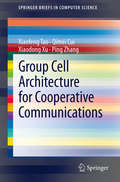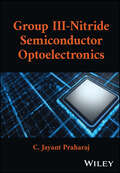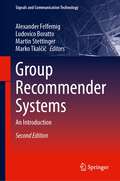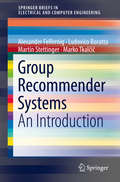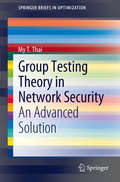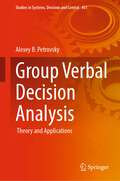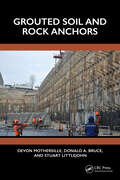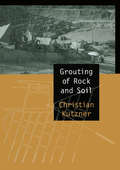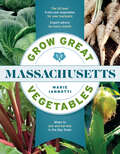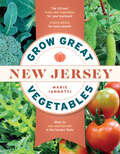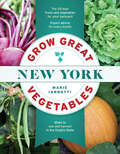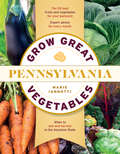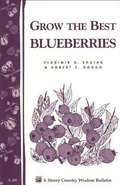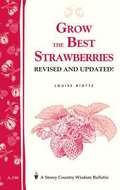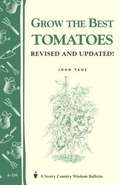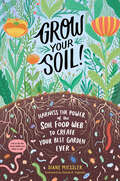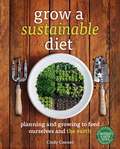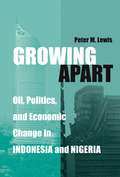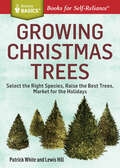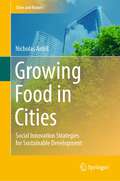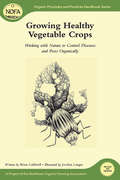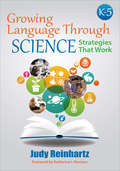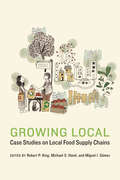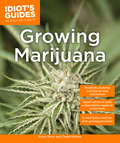- Table View
- List View
Group Cell Architecture for Cooperative Communications
by Ping Zhang Qimei Cui Xiaodong Xu Xiaofeng TaoDriven by the increasing demand for capacity and Quality of Service in wireless cellular networks and motivated by the distributed antenna system, the authors proposed a cooperative communication architecture--Group Cell architecture, which was initially brought forward in 2001. Years later, Coordinated Multiple-Point Transmission and Reception (CoMP) for LTE-Advanced was put forward in April 2008, as a tool to improve the coverage of cells having high data rates, the cell-edge throughput and/or to increase system throughput. This book mainly focuses on the Group Cell architecture with multi-cell generalized coordination, Contrast Analysis between Group Cell architecture and CoMP, Capacity Analysis, Slide Handover Strategy, Power Allocation schemes of Group Cell architecture to mitigate the inter-cell interference and maximize system capacity and the trial network implementation and performance evaluations of Group Cell architecture.
Group III-Nitride Semiconductor Optoelectronics
by C. Jayant PraharajGroup III-Nitride Semiconductor Optoelectronics Discover a comprehensive exploration of the foundations and frontiers of the optoelectronics technology of group-III nitrides and their ternary alloys In Group III-Nitride Semiconductor Optoelectronics, expert engineer Dr. C. Jayant Praharaj delivers an insightful overview of the optoelectronic applications of group III-nitride semiconductors. The book covers all relevant aspects of optical emission and detection, including the challenges of optoelectronic integration and a detailed comparison with other material systems. The author discusses band structure and optical properties of III-nitride semiconductors, as well as the properties of their low-dimensional structures. He also describes different optoelectronic systems such as LEDs, lasers, photodetectors, and optoelectronic integrated circuits. Group III-Nitride Semiconductor Optoelectronics covers both the fundamentals of the field and the most cutting-edge discoveries. Chapters provide thorough connections between theory and experimental advances for optoelectronics and photonics. Readers will also benefit from: A thorough introduction to the band structure and optical properties of group III-nitride semiconductors Comprehensive explorations of growth and doping of group III-nitride devices and heterostructures Practical discussions of the optical properties of low dimensional structures in group III- nitrides In-depth examinations of lasers and light-emitting diodes, other light-emitting devices, photodetectors, photovoltaics, and optoelectronic integrated circuits Concise treatments of the quantum optical properties of nitride semiconductor devices Perfect for researchers in electrical engineering, applied physics, and materials science, Group III-Nitride Semiconductor Optoelectronics is also a must-read resource for graduate students and industry practitioners in those fields seeking a state-of-the-art reference on the optoelectronics technology of group III-nitrides.
Group Recommender Systems: An Introduction (Signals and Communication Technology)
by Alexander Felfernig Marko Tkalčič Ludovico Boratto Martin StettingerThis book discusses different aspects of group recommender systems, which are systems that help to identify recommendations for groups instead of single users. In this context, the authors present different related techniques and applications. The book includes in-depth summaries of group recommendation algorithms, related industrial applications, different aspects of preference construction and explanations, user interface aspects of group recommender systems, and related psychological aspects that play a crucial role in group decision scenarios.
Group Recommender Systems: An Introduction (Springerbriefs In Electrical And Computer Engineering)
by Alexander Felfernig Marko Tkalčič Ludovico Boratto Martin StettingerThis book presents group recommender systems, which focus on the determination of recommendations for groups of users. The authors summarize different technologies and applications of group recommender systems. They include an in-depth discussion of state-of-the-art algorithms, an overview of industrial applications, an inclusion of the aspects of decision biases in groups, and corresponding de-biasing approaches. The book includes a discussion of basic group recommendation methods, aspects of human decision making in groups, and related applications. A discussion of open research issues is included to inspire new related research. The book serves as a reference for researchers and practitioners working on group recommendation related topics.
Group Testing Theory in Network Security
by My T. ThaiGroup Testing Theory in Network Security explores a new branch of group testing theory with an application which enhances research results in network security. This brief presents new solutions on several advanced network security problems and mathematical frameworks based on the group testing theory, specifically denial-of-service and jamming attacks. A new application of group testing, illustrated in this text, requires additional theories, such as size constraint group testing and connected group testing. Included in this text is a chapter devoted to discussing open problems and suggesting new solutions for various network security problems. This text also exemplifies the connection between mathematical approaches and practical applications to group testing theory in network security. This work will appeal to a multidisciplinary audience with interests in computer communication networks, optimization, and engineering.
Group Verbal Decision Analysis: Theory and Applications (Studies in Systems, Decision and Control #451)
by Alexey B. PetrovskyThis book describes an original approach to solving tasks of individual and collective choice: classification, ranking, and selection of multi-attribute objects. Object representation with multisets allows considering simultaneously numerical and symbolic variables. In group verbal decision analysis, judgments of all participants are taken into account without a compromise between contradictory. Natural language is used to describe problems and objects, formalize knowledge of experts and preferences of decision makers, and explain results. Verbal methods and technologies are more transparent, less laborious for a person, and weakly sensitive to measurement errors. The book also includes examples of applying new tools in real ill-structured high-dimensional choice tasks. It is intended for researchers, managers, consultants, analysts, and developers as well as for teachers and students of applied mathematics, computer science, information processing, engineering, economics, and management.
Grouted Soil and Rock Anchors
by Devon Mothersille Donald A. Bruce Stuart LittlejohnThis book delves deep into the crucial aspects of grouted soil and rock anchors, providing a contemporary perspective on the best practices in anchor technology that are directly applicable to the work of consulting engineers, contractors and students in the field.The book comprehensively covers aspects of anchor design, construction, testing, durability and maintenance, as well as the fundamental characteristics of ground and groundwater aggressivity. It adheres to Eurocode 7 and the main current standards and codes of practice, ensuring the information is up-to-date and reliable. The extensive case histories provide real-world examples of successful projects, demonstrating the importance of proper planning, installation and maintenance.Grouted Soil and Rock Anchors is written in a clear, accessible style to suit a broad range of readers, from those who are new to the field to experienced engineers.
Grouting of Rock and Soil
by Christian KutznerDeals with the design and execution of grouting works in all kinds of rock and soil, including jet grouting. Design principles are discussed whereby different approaches, exercised in different parts of the world, are compared to each other and evaluated.
Grow Great Vegetables in Massachusetts (Regional Vegetable Gardening Series)
by Marie IannottiGet the Inside Dirt, Massachusetts!Grow Great Vegetables in Massachusetts is the ultimate guide to growing food in the Bay State! This must-have guide to growing vegetables, fruits, and herbs provides you with insider advice on climate zones, average frost dates, and growing season details. Information includes details on sun, soil, fertilizer, mulch, water, and the best varieties for your region. A garden planning section helps with design and crop rotation, and monthly lists explain what to do from January through December. In-depth profiles of fifty best edibles help ensure a can’t-miss harvest.
Grow Great Vegetables in New Jersey (Regional Vegetable Gardening Series)
by Marie IannottiGet the Inside Dirt, New Jersey!Grow Great Vegetables in New Jersey is the ultimate guide to growing food in the Garden State! This must-have guide to growing vegetables, fruits, and herbs provides you with insider advice on climate zones, average frost dates, and growing season details. Information includes details on sun, soil, fertilizer, mulch, water, and the best varieties for your region. A garden planning section helps with design and crop rotation, and monthly lists explain what to do from January through December. In-depth profiles of fifty best edibles help ensure a can’t-miss harvest.
Grow Great Vegetables in New York (Regional Vegetable Gardening Series)
by Marie IannottiGet the Inside Dirt, New York!Grow Great Vegetables in New York is the ultimate guide to growing food in the Empire State! This must-have guide to growing vegetables, fruits, and herbs provides you with insider advice on climate zones, average frost dates, and growing season details. Information includes details on sun, soil, fertilizer, mulch, water, and the best varieties for your region. A garden planning section helps with design and crop rotation, and monthly lists explain what to do from January through December. In-depth profiles of fifty best edibles help ensure a can’t-miss harvest.
Grow Great Vegetables in Pennsylvania (Regional Vegetable Gardening Series)
by Marie IannottiGet the Inside Dirt, Pennsylvania!Grow Great Vegetables in Pennsylvania is the ultimate guide to growing food in the Keystone State! This must-have guide to growing vegetables, fruits, and herbs provides you with insider advice on climate zones, average frost dates, and growing season details. Information includes details on sun, soil, fertilizer, mulch, water, and the best varieties for your region. A garden planning section helps with design and crop rotation, and monthly lists explain what to do from January through December. In-depth profiles of fifty best edibles help ensure a can’t-miss harvest.
Grow The Best Blueberries
by Vladimir G. Shutak Robert E. GoughSelection, planting, care and protection of highbush blueberries.
Grow The Best Strawberries (Revised and Updated Edition)
by Louise RiotteHow to select, plant, care for, harvest and use strawberries.
Grow Your Soil!: Harness the Power of the Soil Food Web to Create Your Best Garden Ever
by Diane MiesslerGrowing awareness of the importance of soil health means that microbes are on the minds of even the most casual gardeners. After all, anyone who has ever attempted to plant a thriving patch of flowers or vegetables knows that what you grow is only as good as the soil you grow it in. It is possible to create and maintain rich, dark, crumbly soil that&’s teeming with life, using very few inputs and a no-till, no-fertilizer approach. Certified permaculture designer and lifelong gardener Diane Miessler presents the science of soil health in an engaging, entertaining voice geared for the backyard grower. She shares the techniques she has used — including cover crops, constant mulching, and a simple-but-supercharged recipe for compost tea — to transform her own landscape from a roadside dump for broken asphalt to a garden that stops traffic, starting from the ground up.
Grow a Sustainable Diet
by Cindy ConnerEveryone loves to prepare a meal with ingredients fresh from their own garden. But for most of us, no matter how plentiful our harvest, homegrown produce comprises only a fraction of what we eat. And while many gardening guides will tell you everything you ever wanted to know about individual crops, few tackle the more involved task of helping you maximize the percentage of your diet you grow yourself.Grow a Sustainable Diet will help you develop a comprehensive, customized garden plan to produce the maximum number of calories and nutrients from any available space. Avoid arriving in August buried under a mountain of kale or zucchini (and not much else) by making thoughtful choices at the planning stage, focusing on dietary staples and key nutrients. Learn how to calculate: Which food and cover crops are best for your specific requirements How many seeds and plants of each variety you should sow What and when to plant, harvest, and replant for maximum yieldFocusing on permaculture principles, bio-intensive gardening methods, getting food to the table with minimum fossil fuel input, and growing crops that sustain both you and your soil, this complete guide is a must-read for anyone working towards food self-sufficiency for themselves or their family.Cindy Conner is a permaculture educator, founder of Homeplace Earth, and the producer of two popular instructional DVDs on sustainable gardening. Her passion is exploring growing a complete diet in a small space while minimizing the use of fossil fuels.
Growing Apart: Oil, Politics, and Economic Change in Indonesia and Nigeria
by Peter M. Lewis"Growing Apartis an important and distinguished contribution to the literature on the political economy of development. Indonesia and Nigeria have long presented one of the most natural opportunities for comparative study. Peter Lewis, one of America's best scholars of Nigeria, has produced the definitive treatment of their divergent development paths. In the process, he tells us much theoretically about when, why, and how political institutions shape economic growth. " —Larry Diamond, Senior Fellow, Hoover Institution "Growing Apartis a careful and sophisticated analysis of the political factors that have shaped the economic fortunes of Indonesia and Nigeria. Both scholars and policymakers will benefit from this book's valuable insights. " —Michael L. Ross, Associate Professor of Political Science, Chair of International Development Studies, UCLA "Lewis presents an extraordinarily well-documented comparative case study of two countries with a great deal in common, and yet with remarkably different postcolonial histories. His approach is a welcome departure from currently fashionable attempts to explain development using large, multi-country databases packed with often dubious measures of various aspects of 'governance. '" —Ross H. McLeod, Editor,Bulletin of Indonesian Economic Studies "This is a highly readable and important book. Peter Lewis provides us with both a compelling institutionalist analysis of economic development performance and a very insightful comparative account of the political economies of two highly complex developing countries, Nigeria and Indonesia. His well-informed account generates interesting findings by focusing on the ability of leaders in both countries to make credible commitments to the private sector and assemble pro-growth coalitions. This kind of cross-regional political economy is often advocated in the profession but actually quite rare because it is so hard to do well. Lewis's book will set the standard for a long time. " —Nicolas van de Walle, John S. Knight Professor of International Studies, Cornell University Peter M. Lewis is Associate Professor and Director of the African Studies Program, Johns Hopkins University, School of Advanced International Studies.
Growing Christmas Trees: Select the Right Species, Raise the Best Trees, Market for the Holidays. A Storey BASICS® Title (Storey Basics)
by Patrick White Lewis HillGrowing beautiful Christmas trees is a great way to generate off-season farm income and make better use of your land. From selecting a site and planting the right species to marketing and selling trees, this Storey BASICS® guide shows you how to build and maintain your own small tree nursery. Including handy tips for making handcrafted kissing balls and holiday wreaths, Growing Christmas Trees covers everything you need to know to successfully cultivate stunning evergreens that will provide income and bring holiday cheer.
Growing Food in Cities: Social Innovation Strategies for Sustainable Development (Cities and Nature)
by Nicholas ArdillThis book examines social innovation strategies in the collaborative development of spaces for growing food in cities. It enables readers to gain valuable insights into an innovative social and spatial practice whilst advancing knowledge in an emerging area of research. The book will also be of great relevance to social activists, urban designers, planners, and decision-makers with an interest in applying this expertise to their own neighbourhoods and cities. Urban food growing spaces have multiplied in recent times. This green and inclusive urbanism creates social value for the health, wellbeing, and welfare of local inhabitants. Therefore, there is a convincing argument to investigate innovative spatial practices that can enable cities to meet the needs of an increasing population. Despite the mounting interest in collective approaches to sustainable development, limited attention has been given to the diverse ways in which this social action has been pursued. How are urban food growing spaces produced through social innovation? What are the innovative processes that can be translated in a replicable model to other cities, yet suitable for local needs, to support the development of healthier, more socially just built environments?
Growing Healthy Vegetable Crops
by Brian CaldwellPart of the NOFA Guides. Includes information on:-Basic concepts of pest control (host susceptibility, soil health, genetic resistance, ecosystem factors)-Practical approaches (crop cultural practices, rescue treatments, special section on mammals and birds, food safety)-Farm design for pest reduction (diversity, crop rotation)-Unorthodox approaches (farmers out of the box)-Identifying pests-Crop-by-crop pests and practices
Growing Language Through Science, K-5: Strategies That Work
by Judy G. ReinhartzFoster life-long teacher learning embedded in effective teaching practices and the science standards Growing Language Through Science offers a model for contextualizing language and promoting academic success for all students, particularly English learners in the K-5 science classroom, through a highly effective approach that integrates inquiry-based science lessons with language rich hand-on experiences. You’ll find A wealth of instructional tools to support and engage students, with links to the Next Generation Science Standards (NGSS) Presentation and assessment strategies that accommodate students’ diverse needs Ready-to-use templates and illustrations to enrich the textual discussion Field-tested teaching strategies framed in the 5Es used in monolingual and bilingual classrooms
Growing Language Through Science, K-5: Strategies That Work
by Judy G. ReinhartzFoster life-long teacher learning embedded in effective teaching practices and the science standards Growing Language Through Science offers a model for contextualizing language and promoting academic success for all students, particularly English learners in the K-5 science classroom, through a highly effective approach that integrates inquiry-based science lessons with language rich hand-on experiences. You’ll find A wealth of instructional tools to support and engage students, with links to the Next Generation Science Standards (NGSS) Presentation and assessment strategies that accommodate students’ diverse needs Ready-to-use templates and illustrations to enrich the textual discussion Field-tested teaching strategies framed in the 5Es used in monolingual and bilingual classrooms
Growing Local: Case Studies on Local Food Supply Chains (Our Sustainable Future)
by Michael S. Hand Robert P. King Miguel I. GomezIn an increasingly commercialized world, the demand for better quality, healthier food has given rise to one of the fastest growing segments of the U.S. food system: locally grown food. Many believe that “relocalization” of the food system will provide a range of public benefits, including lower carbon emissions, increased local economic activity, and closer connections between consumers, farmers, and communities. The structure of local food supply chains, however, may not always be capable of generating these perceived benefits.Growing Local reports the findings from a coordinated series of case studies designed to develop a deeper, more nuanced understanding of how local food products reach consumers and how local food supply chains compare with mainstream supermarket supply chains. To better understand how local food reaches the point of sale, Growing Local uses case study methods to rigorously compare local and mainstream supply chains for five products in five metropolitan areas along multiple social, economic, and environmental dimensions, highlighting areas of growth and potential barriers. Growing Local provides a foundation for a better understanding of the characteristics of local food production and emphasizes the realities of operating local food supply chains.
Growing Marijuana: Expert Advice to Yield a Dependable Supply of Potent Buds (Idiot's Guides)
by Kevin Oliver Chadd McKeenCultivate your personal cannabis crop with expert techniques and know-how. As marijuana laws in the United States become less restrictive, more and more people are searching for basic marijuana gardening instructions. But cultivating pot isn&’t like growing houseplants or vegetables, especially if you desire maximum potency and yield. It takes precision, and among other things you need female plants, very specific temperature, nutrients, humidity, and lighting at different times during the plant&’s lifespan to maximize the quality and quantity of your yield. Idiot&’s Guides®: Growing Marijuana covers it all—in a simple, concise way to help you increase both the yield and quality of your personal harvest. Here&’s what you&’ll find in this clear, visual guide: • Instructions on how to grow and maintain a small marijuana garden for your own noncommercial use, with more than 500 full-color photos and illustrations • The full spectrum of options available for growing marijuana, from indoor, climate-controlled systems to open-air, outdoor growing • Time-tested and modern methods for strain selection, disease and pest prevention, and proper plant nutrition • Expert advice to yield a consistent and dependable supply of buds
